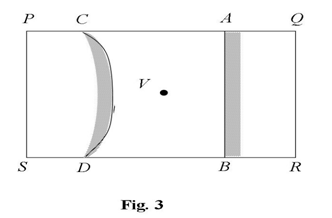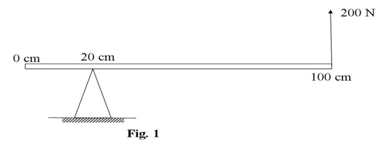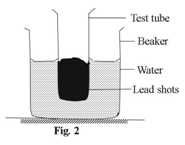1. (a) (i) What is virtual image?
(ii) Under what condition is a virtual image formed by a concave mirror?
(b) Describe how the foal length of a concave mirror can be determined.
(c) An object 2.0 cm is placed 8 cm in front of a convex lens of focal length 12 cm. construct ray diagram to determine the;
(i) Position of the image
(ii) Magnification produced
(d) (i) what is meant by refractive index of material?
(ii) Explain how dispersion of while light takes place in glass prism.
2. (a) Define the Hertz as applied to waves.
(b) (i) Explain what is meant by resonance.
(ii) Describe an experiment to measure the speed of sound in air using a resonance tube?
(c ) Figure 3 shows a point ,V of frequency 30 Hz used to produce water ripples of speed 60 cms-1 in a ripple tank PQRS. If AB and CD are straight and convex, barriers respectively

(i) Sketch wave forms showing the incident and reflected wave forms at the barriers.
(ii) Find the distance between two successive crests of the waves produced by the vibrator.
(d) (i) what is an echo?
(iii) State one practical use of echoes.
3. (a) (i) Define moment of a force.
(ii) Describe a simple experiment to verify the principle of moments.
(iii) A uniform meter rule is pivoted at the 20 cm mark as shown in
Figure 1

When a force of 200 N acts on it the 100 cm mark, the meter rule remains in a horizontal position. Find the weight of the meter rule.
(b) State Archimedes principle.
(c ) A test tube is partly filled with lead shorts and made to float in water as shown in figure 2.

The length of the tube submerged and the level of water in the beaker are noted. State what happens to the length of the tube submerged and the level of water in the beaker when
(i) Some lead shots are removed from the test tube.
(ii) The temperature of the water is increased
(d) Explain observation in (c) (i)
4(a) (i) What is force?
(iii) State the unit of force
(b) A block of wood is placed on a rough table and pulled horizontally using a string attached to it. Draw a labeled sketch diagram showing the force acting on the block.
(c) Describe an experiment to demonstrate surface tension in a liquid
(d) A parachutist falling with a constant vertical velocity of 16 ms-1 is being blown by wind horizontally at 12 ms-1 .
(i) Find the resultant velocity of the parachutist.
(ii) If the parachutist jumps from a height of 500 m directly above aground target, find the horizontal distance by which the parachutist will miss the target on landing.
(e) Explain why a ship made of iron and steel floats on water.
5. (a) Define specific heat of vaporization.
(b) Describe how to determine the specific latent heat of the vaporization of steam.
(c ) A copper calorimeter weighs 0.1 kg when empty and 0.3 kg when partially filled with water at 400C. A mass of 0.005 kg of steam is passed into the calorimeter until a final steady temperature is reached. Neglecting heat losses to the surroundings, calculate the final temperature of the calorimeter and its contents,
(specific latent heat of vaporization of steam=2.26 x 106Jkg-1, specific heat capacity of copper =400 Jkg-1 K-1))
(d) (i) What is saturated vapour ?
(ii) Use kinetic theory of matter to explain how evaporation causes cooling.
6. (a) what is a volt?
(b) A lamp is marked 240 V, 60 W Explain what this means.
(c ) (i) Use a diagram to show how three identical cells, each of e.m.f 1.5 Vand internal resistance 0.1 Ω, can be arranged to give minimum e. m.f
(iii) Calculate the current flowing in the circuit of the arrangement in (c ) (i), if two resistors of resistances 4Ω and 5Ω are included in series in the circuit.
(d) (i) state two sources of e.m.f
(ii) With the aid of a labeled diagram, describe how an accumulator can be charged fully.
7. (a) what is meant by
(i) Magnetic saturation
(ii) Magnetic screening
(b) (i) Describe the domain theory of magnetism.
(ii) Use the above theory to explain demagneticsation.
(c ) Draw magnetic field line due to
(i) A bar magnet placed horizontally with it’s in the magnetic meridian and its north pole pointing south.
(ii) A bar of unmagnetized iron placed along the axis of the earth field.
(d) (i). State how a galvanometer can be used to measure large currents.
(ii). A galvanometer gives a full scale deflection for a current of 0.1 A, and its resistance is 0.5 Ω. Determine the value of the resistance necessary to convert it into a voltmeter which reads up to 100 V
8 (a) (i) What are cathode rays?
(ii) Describe how cathode rays are produced in a cathode ray tube.
(b) With reference to an X-ray tube explain
(i) Why the tube has to be evacuated.
(ii) Why the tungsten target is embedded in copper block.
(iii) How the penetrating power of X-ray can varied.
(c ) (i) what is radioactivity?
(iii) Describe one use of radioactivity.
